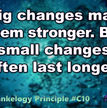
C08 General Principle
Problems persist without solution where needs resist full resolution.
Image: Pixabay – Pexels (click on meme to see source image)
Summary
The less needs resolve, the more functioning suffers. The more functioning suffers, the more a problem persists. Beneath each problem are a set of unmet needs. The more those needs resolve, the further the problem clears up. The more other needs stand in the way, or conflict with a given solution, the less a problem can be resolved. The more needs get resolved, the more a problem gets solved.
Description
Which do you think is more likely?
Resolving every need is some kind of unattainable ideal.
OR
A society putting pain relief over resolving needs, and expect all to be okay, is some kind of unattainable ideal.
Anankelogy
What we call a problem simply occurs after a need or needs will not resolve. The less resolved the needs, the less the ability to adequately or fully function. That’s a problem.
You’ve got a problem with dehydration? Your need for sufficient water is not being resolved. You’ve got a problem suffering loneliness? Your need for social connect is not being resolved. You’ve got a problem being trusted to do things for yourself? Your need for independence is not being resolved.
This could be presented as a simple formula:
Need – Resolution = Problem
Solving a problem simply means resolving the needs creating that problem. There are no problems apart from unresolved needs. Just as there is no pain apart from unresolved needs.
As your ability to function goes down, your level of emotional pain goes up. Physical and emotional pain only exists to warn you of threats to your ability to fully function.
Minor limits cause marginal and often imperceptible pain. You feel mildly irritated when something doesn’t quite go as planned, for example. But since you can mostly function anyways, you do not feel that much emotional pain.
If you feel the floor fall out beneath during a major earthquake, you’re immediately feel overwhelmedby a major limitation on your ability to function—indeed, to survive. We naturally gage problems by the severity of their restrictions on our functionality.
Resolve all needs fully, and you restore the ability to fully function. Any pain clears up without threats to report. In that moment, your problems go away. At lease in a more perfect world.
Need-response
Increasing isolation and alienation pulls us into leaning more on impersonal institutions to ease the pain of our mounting problems. We seek better policies, to try to fix the external dimension of our problems. We seek therapy to try to fix ourselves.
We rarely try to address both the internal and external dimensions at the same time, until now. Need-response exists to simultaneously address the inward and outward aspects of problems crashing into your life.
Need-response recognizes how you cannot solve your problems if only trying to address its outward components with impersonal rules. And need-response recognizes you will never completely solve your problems if only looking within Because need-response recognizes your wellness as psychosocial.
Reactive Problem
Most institutional options do not aim to resolve your affected needs fully. Psychotherapy largely seeks to ease your pain from problems, without fully addressing the external components to that problem. Legal options in the judiciary and politics offer relief to the winning side in a legal contest, with little if any follow up to ensure fully functionality.
These institutions tend to anticipate your continued inability to fully function. They’re often incentivized to keep you at some level of incapacity to continue relying on them to cope. The more you become dependent on these limited options, the more you normalize them as the only options you can trust.
If assaulted by someone you know, for example, the legal system steps in to mediate the conflict. It may condition psychotherapy to let you avoid jail time, typically without addressing the broader problems behind the assault. This official “schizophrenic” psychosocially imbalanced approach does little to address any of the problems causing the many conflicts we repeatedly face.
The more these institutional options have you focus externally one moment and then internally at another, ignoring any intersectionality or dismissing any holistic view, the more you can get pulled into psychosocial imbalance. That itself prompts pain as your emotions warn you of your limited functionality.
You can get to the point of feeling you must avoid facing any further pain. That includes avoiding the natural discomfort often required to fully resolve a need. Instead of processing your anger, you suppress it. Reacting to your pain can leave you in more pain.
You then fail to recognize your anger reporting your unacceptance of disappointment. Instead of examining your expectations and realigning your anticipations, your discomfort avoidance leaves you trapped in the problem of such recurring pain of unresolved needs. You describe yourself feeling angry, with little awareness of the full scope of the problem you face. Now that itself is a huge problem.
Responsive Solution
Need-response exists to simultaneously address both the internal and external contributors to problems. A wellness campaign begins with an internal focus. It has you address your internal capacities to set a foundation to reliably address external matters.
The campaign then builds social supports, to enable you and support you to speak truth to power (STTP). But in ways that incentivize the powerful to listen to those impacted (LTTI). As you address the needs to solve your own problem, you support others to address the needs behind their problems.
Perhaps you’re not ready to commit to the demands of a full wellness campaign. Responsivismoffers tools to start out on your own. These can equip you to simultaneously address the internal and external components of problems you endure.
By integrating internal and external contributors to problems, need-response gears you toward psychosocial balance. The more you can resolve your problem-affected self-needs on par with your problem-affected social needs, the much more you can function.
In sharp contrast to current institutional “avoidant adversarial” options, you mutually engage (i.e., engaging mutuality) what others also need. The more you support others to solve their problems by addressing their underserved needs, the more they can capably support you to solve your problems.
Along the way, you can help resolve each other’s deeper needs for meaningfulness, for purpose, for social connection, for pain removal, and for reaching more of their life’s full potential.
Responding to your needs
How does this principle speak to your experience of needs? Post in our Engagement forum your thoughtful response to one of these:
This all sounds sweeter in theory than visible in practice.
What if the other side cannot admit we have a problem?
What’s the point of addressing a problem if we cannot identify all the affected needs?
The more I get to the bottom of a problem, the more problems I find.
Instead of selecting one of these, post your own engagement feedback about your experience with the subject of this principle. Remember the aim is to improve our responsiveness to each other’s needs, toward their full resolution. If you’re new at posting here, first check the guide below.
Engagement guide
Any visitor to the Engagement forum can view all posts. So do keep that in mind when posting. Sign up or sign in to comment on these posts and to create your own posts. Using this platform assumes you agree to our terms of use and privacy policy. Remember to keep the following in mind:
-
Quote the principle you are responding to, and its identifier letter & number. Let’s be specific.
-
Demonstrate need-responsiveness in your interactions here. Let’s respect each other.
-
Engage supportive feedback from others on this platform. Let’s grow together.
Together, let’s improve our need-responsiveness. Together, let’s spread some love.
.png)









